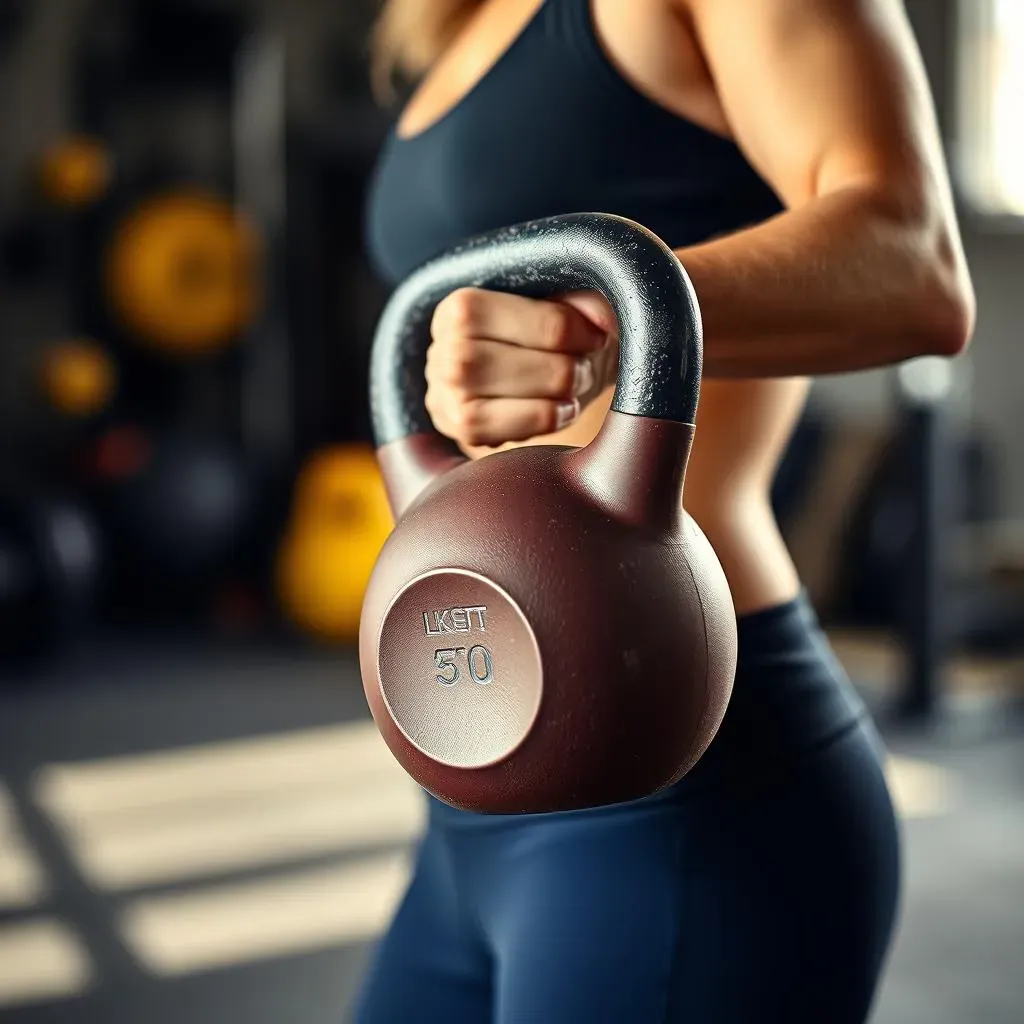Table of Contents
Ready to unlock a world of strength and fitness? This beginner kettlebell workout plan is your passport to a stronger, more confident you. Forget boring routines; kettlebells offer a dynamic, full-body workout that's both effective and fun. Whether you're a complete newbie to exercise or just looking to spice up your fitness regime, this guide will equip you with everything you need to get started. We'll cover selecting the right kettlebell for your needs, mastering fundamental techniques to prevent injury, and building a personalized workout routine that fits your schedule and goals. You'll discover the essential exercises that form the foundation of any beginner kettlebell program, learning how to perform them safely and effectively. We'll also show you how to progress gradually, avoiding burnout and maximizing your results. This isn't just another workout; it's a journey to a fitter, healthier you. So grab your kettlebell, let's embark on this exciting adventure together, and discover the transformative power of a beginner kettlebell workout plan!
Getting Started: Choosing Your Kettlebell and Mastering Basic Form

Getting Started: Choosing Your Kettlebell and Mastering Basic Form
Choosing the Right Kettlebell
Picking your first kettlebell can feel overwhelming, but it doesn't have to be! Think of it like choosing a paintbrush – you wouldn't start with a giant one for a tiny detail, right? Start with a lighter weight, around 8-12kg for women and 12-16kg for men. You can always progress to heavier weights later. Don't worry about looking like a pro; focus on proper form first. Consider the type too – a standard kettlebell is great for beginners, but if you're aiming for competitions one day, then a competition kettlebell might be worth considering. Check out our guide on basic kettlebell exercises to get a better idea of what feels comfortable.
Remember, the goal isn't to lift the heaviest weight possible; it's to perform each exercise with perfect form. Poor form leads to injuries, and nobody wants that. It's better to start light and gradually increase the weight as you get stronger. Think of it as building a strong foundation – you wouldn't build a skyscraper on shaky ground, would you?
Weight Range | Recommended For |
|---|---|
8-12kg | Beginner Women |
12-16kg | Beginner Men |
Mastering the Kettlebell Grip
Before you start swinging, pressing, or squatting, let's talk about the grip. A proper grip is crucial for both safety and effectiveness. You want a firm, but not overly tight, grip. Think of it like holding a baby bird – gentle but secure. Too loose, and you risk dropping the kettlebell (ouch!). Too tight, and you'll cramp up before you even begin. Experiment with different grips to find what's most comfortable for you. For beginners, a neutral grip (palms facing each other) often works best.
Practice your grip with lighter weights initially. Get comfortable holding the kettlebell in various positions – you'll be using it in many different ways throughout your workouts. Check out some helpful videos online to see how others hold the kettlebell. If you're struggling, consider starting with a beginner kettlebell workout focusing on simple exercises to build confidence.
- Neutral Grip (palms facing each other)
- Pronated Grip (palms facing down)
- Supinated Grip (palms facing up)
Building a Strong Foundation: Warm-up and Cool-down
Never underestimate the importance of a proper warm-up and cool-down. Think of it as preparing your car engine before a long drive or letting it idle after a long trip. A warm-up prepares your muscles for exercise, improving blood flow and reducing the risk of injury. Start with 5-10 minutes of light cardio, like jogging in place or jumping jacks. Then, perform some dynamic stretches, such as arm circles, leg swings, and torso twists. This will help loosen up your joints and get your body ready to move.
After your workout, take some time to cool down. Static stretches, holding each stretch for 20-30 seconds, will help reduce muscle soreness and improve flexibility. Focus on major muscle groups worked during your workout, such as your legs, back, and shoulders. This will help your body recover and prepare you for your next workout. Don't skip this crucial step! You can find additional warm-up and cool-down ideas in our 30-minute beginner kettlebell workout guide.
Essential Kettlebell Exercises for Beginners: A FullBody Workout

Essential Kettlebell Exercises for Beginners: A FullBody Workout
Kettlebell Swings: The Foundation of Fitness
Let's start with the king of kettlebell exercises: the swing. It's deceptively simple, yet incredibly effective for building strength and endurance. Think of it as a full-body power move, engaging your legs, core, and back all at once. The swing is amazing for building that posterior chain – glutes, hamstrings, and lower back – which are often neglected in other workouts. You'll feel the burn, and you'll feel stronger. Remember to hinge at your hips, not your waist, and keep your core tight throughout the movement. Start with lighter weights and focus on proper form before increasing the weight. Don't rush it; master the technique first. If you're still unsure, check out our guide on beginner kettlebell workouts for more detailed instructions and videos.
A common mistake is rounding the back during the swing. This puts unnecessary strain on your spine, so keep your back straight and core engaged. Imagine you're trying to hold a pencil between your lower back and a wall – you want to maintain that straight line. Another tip is to use your legs to generate power; don't rely solely on your arms and back. Think of it as using your legs like powerful springs, propelling the kettlebell upwards. This will save your back a lot of stress, and you'll be swinging like a pro in no time!
- Keep your back straight
- Engage your core
- Use your legs to generate power
Goblet Squats: Your Legs Will Thank You
Next up is the goblet squat, a fantastic exercise for building leg strength and improving your overall lower body strength. Hold the kettlebell close to your chest, like you're holding a big, heavy goblet. Then, squat down as if sitting in a chair, keeping your back straight and your chest up. Focus on pushing through your heels as you stand back up. The goblet squat is a great way to strengthen your quads, glutes, and hamstrings, without putting too much strain on your lower back. It's a fundamental movement pattern that translates to many other activities in your daily life.
A common mistake is leaning too far forward during the squat, which can put strain on your knees. To avoid this, make sure to keep your chest up and your weight balanced over your heels. Another tip is to keep your knees tracking over your toes – this prevents unnecessary stress on your knees. As with the swing, start with a lighter weight and focus on perfect form before increasing the weight. You might want to try a beginner leg workout specifically designed to help master this movement and build confidence.
Muscle Group | Benefit |
|---|---|
Quads | Strength and Power |
Glutes | Strength and Stability |
Hamstrings | Flexibility and Strength |
Building Your Routine: Sample Workouts and Progression Tips

Building Your Routine: Sample Workouts and Progression Tips
Your First Kettlebell Workout: A Simple 30-Minute Routine
Let's craft your first kettlebell workout! Remember, consistency is key, so start with a manageable routine. Aim for three sessions per week, allowing rest days in between. This simple 30-minute routine focuses on the fundamental exercises we’ve covered: kettlebell swings and goblet squats. You'll perform three sets of 10-12 repetitions for each exercise. Remember to warm up before you start and cool down afterward. This workout is a great starting point, but feel free to adjust it to suit your fitness level. If you're feeling particularly energetic one day, add an extra set. If you need to take a break, that's fine too! Listen to your body; it's your guide.
Don't forget to focus on proper form! It's far more important than the number of repetitions or the weight you lift. Watch videos, practice in front of a mirror, and if possible, get feedback from a qualified fitness professional. Small adjustments can make a huge difference in your results and injury prevention. Starting slow and steady will get you much further than trying to do too much too soon. Need more ideas for a 30-minute routine? Our 30-minute beginner workout has many more options.
- Warm-up (5 minutes)
- Kettlebell Swings (3 sets of 10-12 reps)
- Goblet Squats (3 sets of 10-12 reps)
- Cool-down (5 minutes)
Progressing Your Kettlebell Workout: Gradual Increases
Once you've mastered the basics and feel comfortable with your 30-minute routine, it's time to progress! The key here is gradual increases – don’t jump to heavier weights too quickly. Gradually increase the weight by 2-4kg every 2-4 weeks, depending on your progress. If you find yourself struggling to maintain good form, stay at the current weight until your form improves. Another way to progress is to increase the number of sets or repetitions. Try adding one extra set per workout, or increasing the repetitions by 2-3 per set. Listen to your body and don't push yourself too hard, especially in the beginning.
Consider adding new exercises to your routine every 4-6 weeks. This will challenge your muscles and prevent plateaus. You might want to incorporate exercises like kettlebell rows, presses, or lunges, or even some core work. Remember to learn the correct form for each new exercise before increasing the weight or repetitions. Don't be afraid to consult additional resources like our guide on the four best kettlebell exercises, and remember to always prioritize proper form over speed or weight. Remember, consistency is key!
Week | Weight (kg) | Sets | Reps |
|---|---|---|---|
1-4 | 8-12 (women), 12-16 (men) | 3 | 10-12 |
5-8 | Increase by 2-4kg | 3-4 | 10-12 |
Listening to Your Body: Rest and Recovery
This might sound obvious, but rest and recovery are just as important as the workouts themselves. Your muscles need time to repair and rebuild after each session. Aim for at least one full rest day per week. If you're feeling particularly sore or fatigued, don't hesitate to take an extra day off. Your body will thank you for it. Ignoring your body's signals can lead to injuries and burnout. Consider active recovery on your rest days – light activities like walking, stretching, or yoga can help promote blood flow and reduce muscle soreness. It's about balance, not just pushing yourself to the limit.
Nutrition also plays a crucial role in recovery. Make sure you're eating a balanced diet with plenty of protein to support muscle growth and repair. Stay hydrated by drinking plenty of water throughout the day. Getting enough sleep is also essential for muscle recovery and overall well-being. Aim for 7-9 hours of quality sleep each night. If you're struggling with sleep, consider adjusting your routine or talking to your doctor. Remember, recovery is not a luxury; it's a necessity for achieving your fitness goals. Check out our additional tips on beginner kettlebell workouts for maximizing your results.